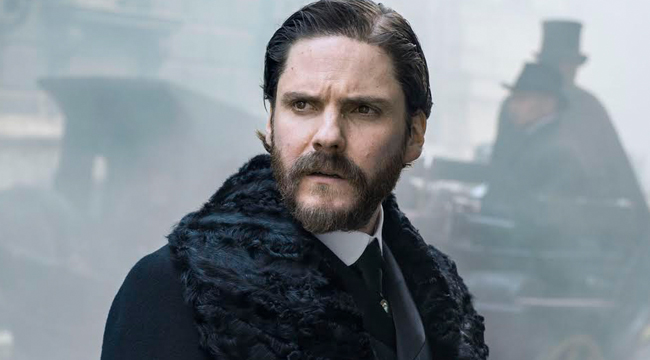
The Alienist was the hot novel in the spring and summer of 1994, a crime procedural with a twist: it was set in the 1890s and dealt with the most primitive days of what we think of as modern police science, as psychologist Laszlo Kreizler and newspaperman John Moore investigated a serial killer of underage prostitutes on the filthy streets of 19th century New York, where a young Teddy Roosevelt was police commissioner. You couldn’t go anywhere without seeing someone carrying a copy, and it seemed obvious that it would soon become a big-budget movie starring, say, Liam Neeson as Kreizler and Brad Pitt as Moore.
Only it never did. The project was stuck in development hell for decades, only emerging when Paramount (the studio that held the film rights) got back into the television game a few years ago. It finally appears as a 10-episode series Monday night on TNT, now starring Daniel Brühl as Kreizler, Luke Evans as Moore, and Dakota Fanning as Sara Howard, Roosevelt’s secretary and the first woman employed by the NYPD for something other than cleaning.
Shot in Budapst, Hungary, where director/producer Jakob Verbruggen (The Fall) and the rest of the crew were able to lovingly recreate the Manhattan of days long gone by, The Alienist — the term used for experts in mental illness back then because those suffering from it were said to be “alienated from their own true natures” — is beautiful to look at. Every bit of trash, every ornate piece of jewelry worn by the members of high society, every rank smell seems to waft off the screen, particularly in an early sequence where a terrified Moore ascends the under-construction Williamsburg Bridge at night to sketch the crime scene that brings Kreizler into action.
But this note-perfect recreation of the past arrives in a future that neither Carr nor the people trying to adapt his book in the ’90s could have conceived: one with an embarrassment of similarly detail-rich period dramas, and a similar glut of shows about the origins of crime-solving techniques.
Just sticking to relatively recent television (as opposed to something like the movie version of From Hell), The Alienist arrives after The Knick and Boardwalk Empire featured a New York only slightly further in the future, Peaky Blinders and Penny Dreadful have done the same across the pond (the latter featuring an alienist character of its own), and Netflix’s Mindhunter tackled the ’70s codification of the kinds of criminal profiling that Kreizler fumbles about with here.
Even the CSI franchise, to a degree, has stolen the material’s thunder: though set a century later, with far more advanced technology, it already saturated the market with the idea of scientists stepping into work that had previously been considered a field for square-jawed tough guys.
The book had all kinds of novelty going for it in the mid-’90s. The TV show lacks that same capacity to surprise, so it (based on the two episodes TNT gave critics) has to lean much more on its story and characters, which were on the sketchy side to begin with(*).
(*) My strongest memories of the novel, which I read along with everybody else that summer, was how tasty Carr made a Delmonico’s steak sound, and a bit about what would later prove to be bunk science, involving photographing the eyeballs of murder victims to see if they recorded the faces of their killers. Little else stuck with me.
Mindhunter was able to find a fresh approach to the serial killer genre by taking a sober look at what makes these monsters tick, focusing on conversation and process rather than lurid crime scene imagery. The Alienist opts for a much more gruesome and sensationalist approach, making sure you get to see every mutilated corpse, watch police scientist twins Marcus and Lucius Isaacson ( Douglas Smith and Matthew Shear) conduct primitive autopsies and test out potential murder weapons on pig carcasses, and get down in the muck with all the gangsters and sneering corrupt cops who allow turn children into sex workers, then murder victims. It’s all meant to shock and titillate but in ways so familiar that the shock value is long gone.
The characters are all variations on relatively stock types: Kreizler as the intense genius who realizes he has to learn to think like a killer to catch him, Moore the reluctant everyman irked by his partner’s many eccentricities, Sara Howard the woman determined to prove herself in a misogyny-dominated trade, Roosevelt as… well, mainly a plot device so far, but also the honest man struggling to clean up the dirty town. The actors are all good, Brühl in particular finding the balance between altruism and obsession, but don’t especially elevate the middling material. (The period setting also forgives the hodgepodge of accents.)
Had the movie been made in the ’90s, it would have had to carve out large chunks of both the plot, along with the scientific detail that made the book a national obsession to begin with (and that remains the most interesting part of the TV show). Being stuck in limbo all these years meant it could arrive in a medium with the time, money, and interest to do a more faithful adaptation — but only after so many others had beaten it to this particular punch.
Alan Sepinwall may be reached at sepinwall@uproxx.com. He discusses television weekly on the TV Avalanche podcast. His new book, Breaking Bad 101, is on sale now.
